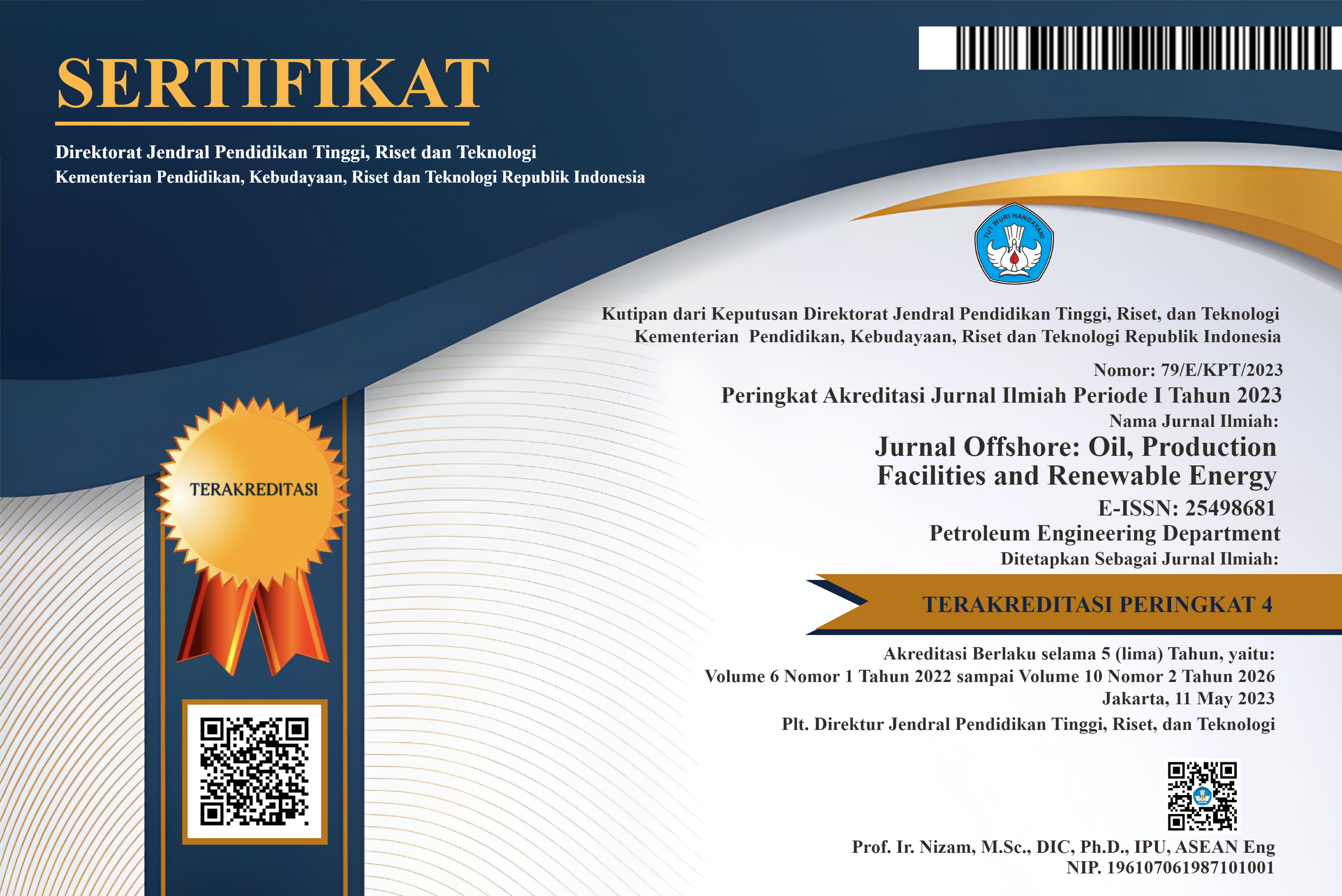Karakteristik Minyak dan Gas Hasil Proses Dekomposisi Termal Plastik Jenis Low Density Polyethylene (LDPE)
DOI:
https://doi.org/10.30588/jo.v1i2.288Keywords:
minyak, gas, pirolisis, sampah plastik, LDPE, oil, pyrolysis, plastic wasteAbstract
Penelitian ini bertujuan untuk mengetahui karakteristik minyak dan gas hasil proses dekomposisi termal (pirolisis) sampah plastik jenis low density polyethylene (LDPE) dengan berbagai variabel laju kenaikan suhu selama proses pirolisis terjadi. Pada proses ini digunakan reaktor pirolisis kapasitas 2 kg dengan laju kenaikan suhu sebesar 2, 4, dan 6 °C/menit sebagai variabel penelitian. Minyak dan gas yang terbentuk ditampung dalam wadah penampung dan diukur rendemennya. Karakteristik gas yang dihasilkan kemudian diuji di laboratorium menggunakan peralatan GC-MS dan peralatan uji sifat fisik khusus untuk minyak hasil pirolisis. Berdasarkan hasil penelitian, didapatkan bahwa semakin tinggi laju kenaikan suhu, minyak yang diahsilkan semakin banyak dan gas semakin sedikit. Rendemen minyak terbesar sebesar 35,83 % dihasilkan pada proses pirolisis dengan laju kenaikan suhu 6 °C/menit, dimana pada saat itu, nilai rendemen gas adalah paling kecil, sebesar 5,83 %. Sementara hasil identifikasi gas, yang paling dominan adalah gas jenis butena, dimana kadarnya semakin kecil seiring dengan laju kenaikan suhu. Kandungan gas butena terbesar sebesar 98% pada laju kenaikan suhu 2 °C/menit. Sementara berdasarkan uji sifat fisik, karakteristik minyak plastik mendekati sifat-sifat bahan bakar minyak, terutama kerosen., sehingga cukup layak apabila dijadikan sebagai bahan bakar alternatif pengganti BBM.
This study aims to determine the characteristics of oil and gas from the thermal decomposition (pyrolysis) process of waste low density polyethylene (LDPE) type plastic with various temperature increase rate variables during the pyrolysis process. In this process a 2 kg capacity pyrolysis reactor is used with a temperature increase of 2, 4, and 6 °C/min as the research variable. The oil and gas that is formed is stored in a container and the yield is measured. The characteristics of the gases produced are then tested in the laboratory using GC-MS equipment and special physical property test equipment for pyrolysis oils. Based on the research results, it was found that the higher the rate of temperature rise, the more oil is produced and the less gas. The largest oil yield of 35.83 % was produced in the pyrolysis process with a rate of temperature rise of 6 °C/min, where at that time, the value of the gas yield was the smallest, amounted to 5.83 %. While the gas identification results, the most dominant is the type of butene gas, where the levels get smaller along with the rate of temperature rise. The biggest butene gas content is 98 % at a rate of temperature rise of 2 °C/min. While based on the physical properties test, the characteristics of plastic oil approach the properties of fuel oil, especially kerosene, so it is quite feasible if used as an alternative fuel to substitute fuel.
References
Ali, M., Ramadhan, A. (2010). Pengolahan Sampah Plastik menjadi Minyak menggunakan Proses Pirolisis, Skripsi Prodi Teknik Lingkungan, Fakultas Teknik Sipil dan Perencanaan. Universitas Pembangunan Nasional “Veteran” Jawa Timur.
Bashir, N. H. H. (2013) Plastic Problem in Africa. Japanese Journal of Veterinary Research, 61, pp. 1–11.
Cahyono, M.S., (2013). Pengaruh Jenis Bahan pada Proses Pirolisis Sampah Organik menjadi Bio-oil sebagai Sumber Energi Terbarukan. Jurnal Sains dan Teknologi Lingkungan. Volume 5, Nomor 2, Juni 2013. Hal.67-76.
Cahyono, M.S., & Styana, U.I.F. (2017). Influence of Hetaing Rate and Temperature on the Yield and Properties of Pyrolysis Oil Obtained from Waste Plastic Bag. Converse: Journal of Energy and Environment Studies (CJEES), Vol.1 No.1, March 2017, pp 1-10.
Direktur Jenderal Minyak dan Gas Bumi, Depatemen Energi dan sumber Daya Mineral. (2009). Keputusan Direktur Jenderal Minyak Dan Gas Bumi Tentang Standar Dan Mutu (Spesifikasi Bahan Bakar Gas Jenis Liquefied Petroleum Gas (LPG) Yang Dipasarkan Di Dalam Negeri. http://hubdat.dephub.go.id/keputusandirjen/384-tahun-1996.
Ermawati, Rahyani (2011). Konversi Limbah Plastik sebagai Sumber Energi Alternatif. Jurnal Riset Industri, Vol.V, No.3, 2011, Hal.257-263.
Kayacan, I., & Dogan, O. M., (2008). Pyrolysis of Low and High Density Polyethylene, Part I: Non-isothermal Pyrolysis Kinetics. Energy Sources, Vol. 30, pp. 385-391.
Kuncser, R, Paraschiv, M., Tazerout, M. & Bellettre, J. (2010). Liquid Fuel Recovery Through Pyrolysis of Polyethylene Waste. Environmental Engineering and Management Journal 9 (10) : 1371–74
Mandala, W.W., Cahyono, M.S., Ma’arif, S., Sukarjo, H.B., Wardoyo. (2016). Pengaruh Suhu terhadap Rendemen dan Nilai Kalor Minyak Hasil Pirolisis Sampah Plastik. Jurnal Mekanika dan Sistem Termal, Vol. 1(2), Agustus 2016 : 49-52.
Naimah, S., Aidha, N.N. (2017). Karakteristik Gas Hasil Proses Pirolisis Limbah Plastik Polietilena (PE) dengan Menggunakan Katalis Residue Catalytic Cracking (RCC). Jurnal Kimia dan Kemasan, 39(1), 31-38, 2017
Pei, T., Xiao-bo, M., De-zhen, C., & Hai, W. (2013). Pyrolysis of waste plastic : Effect of Heating Rate on Product Yields and Oil Properties. Journal Advanced Materials Research, Vol.666, pp 1-10.
Ramadhan, M.A.A, (2014). Pengaruh Variasi Suhu pada Yield Minyak Hasil Pirolisis Plastik. Laporan Penelitian, Laboratorium Teknologi Minyak Bumi, Gas dan Batubara, Jurusan Teknik Kimia, Fakultas Teknik, Universitas Gadjah Mada, Yogyakarta.
Sharuddin, S., Abnisa, F., Daud , W.M.A.W., & Aroua, M.K., (2016).A Review on Pyrolysis of Plastic Wastes. Energy Conversion and Management, Vol. 115, p. 308–326.
Sukarjo, H., Cahyono, M.S., Wardoyo. (2014). Influence of Temperature to Bio-Oil Yield from Organic Waste Pyrolysis Process. Prosiding Seminar Nasional Aplikasi Sains & Teknologi (SNAST), Yogyakarta, 15 November 2014
Surono, U. B., Ismanto (2016) Pengolahan Sampah Plastik Jenis PP , PET dan PE Menjadi Bahan Bakar Minyak dan Karakteristiknya, Jurnal Mekanika Dan Sistem Termal, 1(1), pp. 32–37
Syamsiro, 2015. Kajian Pengaruh Penggunaan Katalis Terhadap Kualitas Produk Minyak Hasil Pirolisis Sampah Plastik. Jurnal Teknik Vol.5 No.1 April 2015.
Syamsiro, M., Arbiyantoro. (2014) Pengolahan Sampah Plastik dari TPA Piyungan menjadi Bahan Bakar Minyak. Jurnal Riset Daerah Vol XIII, No.3. Desember 2014.
Yuliansyah, A.T., Prasetya, A., Ramadhan, M.A.A., & Laksono, R. (2015). Pyrolysis of Plastic Waste to Produce Pyrolytic Oil As an Alternative Fuel. International Journal of Technology (2015) 7 : 1076-1083.
Downloads
Published
How to Cite
Issue
Section
License
Authors retain copyright and grant the Jurnal Offshore right of first publication with the work simultaneously licensed under a Creative Commons Attribution 4.0 International License that allows others to share (copy and redistribute the material in any medium or format) and adapt (remix, transform, and build upon the material) the work for any purpose, even commercially with an acknowledgement of the work's authorship and initial publication in Jurnal Offshore. Authors are able to enter into separate, additional contractual arrangements for the non-exclusive distribution of the journal's published version of the work (e.g., post it to an institutional repository or publish it in a book), with an acknowledgement of its initial publication in Jurnal Offshore. Authors are permitted and encouraged to post their work online (e.g., in institutional repositories or on their website) prior to and during the submission process, as it can lead to productive exchanges, as well as earlier and greater citation of published work (See The Effect of Open Access).















